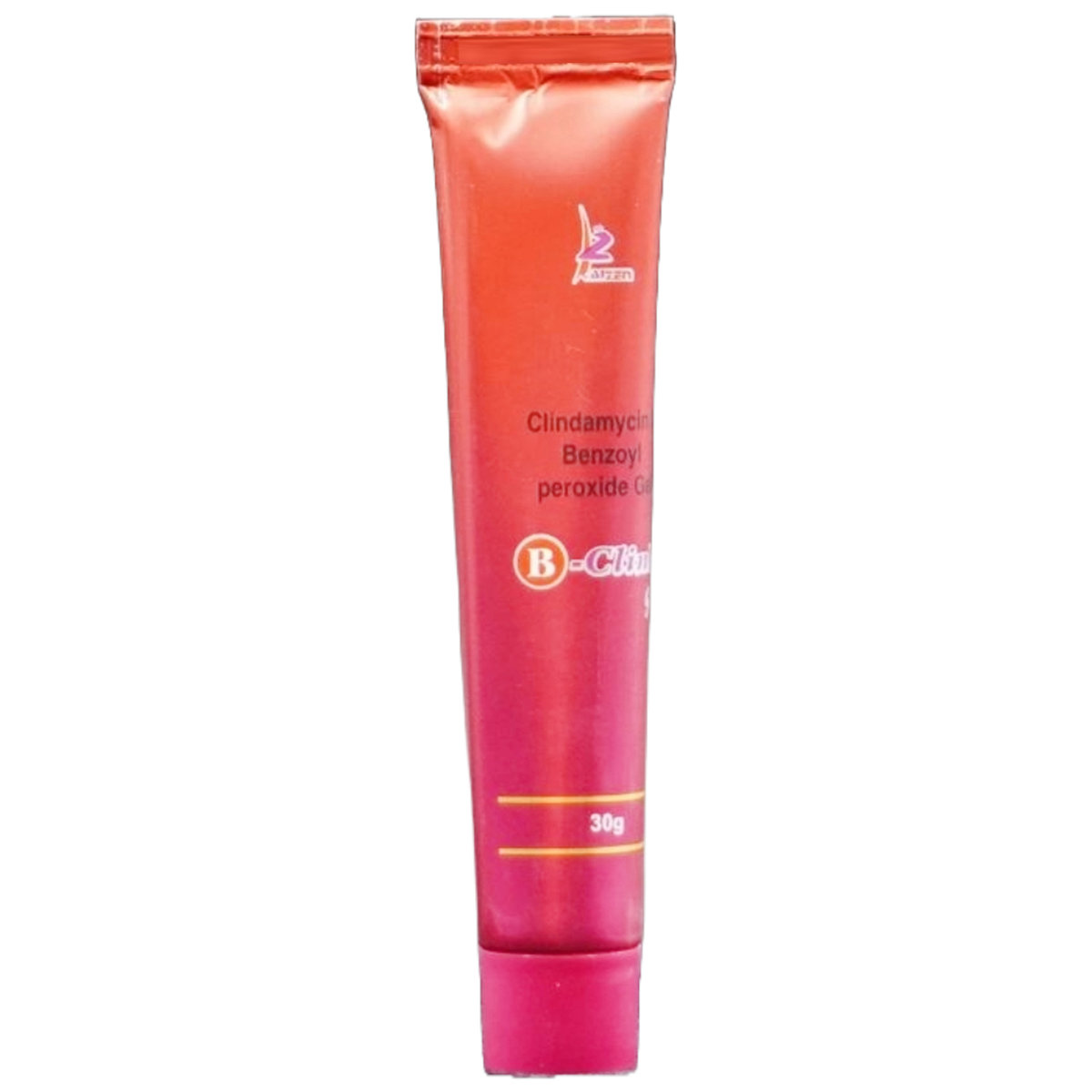Clindamycin+benzoyl Peroxide
About Clindamycin+benzoyl Peroxide
Clindamycin+benzoyl Peroxide belongs to the class of dermatological preparations called ‘antiacne’ used to treat acne (pimples) and kill bacteria, causing acne. Acne is a common skin condition and occurs when hair follicles are blocked with dead skin cells and oil. The acne-causing bacteria feeds on sebum (natural oil produced by skin) causing redness and swelling.
Clindamycin+benzoyl Peroxide is a combination of two drugs: Clindamycin (antibiotic) and Benzoyl peroxide (keratolytic agent). Clindamycin belongs to the class of antibiotics that inhibits the production of essential proteins that are necessary for bacteria to grow, multiply and increase in numbers. Thereby, stops or slows down the growth of bacteria and clears acne. Benzoyl peroxide is a keratolytic agent that breaks down a protein known as keratin (that forms part of skin structure) and removes dead skin cells and softens skin. Thereby, helps in reducing blackheads and whiteheads. Additionally, Benzoyl peroxide possesses antibacterial properties and kills bacteria that cause acne, and reduces inflamed acne spots.
Use Clindamycin+benzoyl Peroxide as prescribed. Clindamycin+benzoyl Peroxide is only for external use. Avoid contact of Clindamycin+benzoyl Peroxide with nose, ears, mouth, or eyes. In case Clindamycin+benzoyl Peroxide comes in contact with these areas accidentally, rinse with warm water thoroughly. Your doctor will advise you how often you take Clindamycin+benzoyl Peroxide based on your medical condition. In some cases, you may experience skin peeling, dry skin, pain, redness, itching, or burning sensation at the site of application. Most of these side effects of Clindamycin+benzoyl Peroxide do not require medical attention and gradually resolve over time. However, if the side effects persist or worsen, please consult your doctor.
If you are known to be allergic to Clindamycin+benzoyl Peroxide or any other medicines, please tell your doctor. Do not apply Clindamycin+benzoyl Peroxide to cuts, open wounds, broken, sunburnt, or sensitive skin areas. Avoid sun exposure while using Clindamycin+benzoyl Peroxide as it may make the skin more sensitive to sunlight and cause sunburn. Wear protective clothing and use sunscreen while going out to protect your skin from sunburn. If you are pregnant or breastfeeding, please inform your doctor before taking Clindamycin+benzoyl Peroxide. Do not apply Clindamycin+benzoyl Peroxide in large amounts or use for a long time than prescribed as it does not give quick or better results but increases the risk of side effects such as redness, irritation, skin peeling, or discomfort. If you have intestine problems, ulcerative colitis (inflammation and sores in the digestive tract), or if you ever had severe diarrhoea caused by any antibiotic medicine, please inform your doctor before taking Clindamycin+benzoyl Peroxide.
Uses of Clindamycin+benzoyl Peroxide
Medicinal Benefits
Clindamycin+benzoyl Peroxide is a combination of two drugs: Clindamycin and Benzoyl peroxide used to treat acne (pimples). Clindamycin is a broad-spectrum antibiotic that acts against both aerobic (grow in the presence of oxygen) and anaerobic (grow in the absence of oxygen) gram-negative and gram-positive bacteria. The acne-causing bacteria feeds on sebum produced by sebaceous (oil) glands in the skin and produce fatty acids and waste products that irritate oil glands, causing redness and swelling. Clindamycin inhibits the production of essential proteins necessary for bacteria to grow, multiply and increase in numbers. Thereby, stops or slows down the growth of bacteria and clears acne. Benzoyl peroxide is a keratolytic agent that breaks down a protein known as keratin (that forms part of skin structure) and removes dead skin cells and softens skin. Thereby, helps in reducing blackheads and whiteheads. Additionally, Benzoyl peroxide possesses antibacterial properties and kills bacteria that causes acne and reduces inflamed acne spots.
Directions for Use
Storage
Side Effects of Clindamycin+benzoyl Peroxide
- Dry skin
- Skin peeling
- Skin itching
- Skin redness
- Pain or burning sensation of the skin
Drug Warnings
If you are known to be allergic to Clindamycin+benzoyl Peroxide or any other medicines, please tell your doctor. Do not apply Clindamycin+benzoyl Peroxide to cuts, open wounds, broken, sunburnt, or sensitive skin areas. Do not swallow Clindamycin+benzoyl Peroxide. In case of accidental swallowing, please consult a doctor. Avoid contact of Clindamycin+benzoyl Peroxide with nose, ears, mouth, or eyes. In case Clindamycin+benzoyl Peroxide comes in contact with these areas accidentally, rinse with warm water thoroughly. Avoid sun exposure while using Clindamycin+benzoyl Peroxide as it may make the skin more sensitive to sunlight and cause sunburn. Wear protective clothing and use sunscreen while going out to protect your skin from sunburn. If you are pregnant or breastfeeding, please inform your doctor before taking Clindamycin+benzoyl Peroxide. You are recommended not to use Clindamycin+benzoyl Peroxide for more than 12 weeks at once. Do not apply Clindamycin+benzoyl Peroxide in large amounts or use for a long time than prescribed as it does not give quick or better results but increases the risk of side effects such as redness, irritation, skin peeling, or discomfort. If you have intestine problems, ulcerative colitis (inflammation and sores in the digestive tract), or if you ever had severe diarrhoea caused by any antibiotic medicine, please inform your doctor before taking Clindamycin+benzoyl Peroxide.
Drug Interactions
Drug-Drug Interaction: Inform your doctor if you are taking vitamin A-related drugs known as retinoids (isotretinoin, bexarotene, adapalene, trifarotene), skeletal muscle relaxants (atracurium, cisatracurium, doxacurium, pancuronium, rocuronium, rapacuronium, vecuronium, pipecuronium, mivacurium, metocurine, tubocurarine, succinylcholine), antibiotics (dapsone).
Drug- Food Interaction: No interactions found.
Drug-Disease Interaction: If you have intestine problems, ulcerative colitis (inflammation and sores in the digestive tract), or if you ever had severe diarrhoea caused by any antibiotic medicine, please inform your doctor before taking Clindamycin+benzoyl Peroxide.
Drug-Drug Interactions Checker List:
Safety Advice

Alcohol
cautionInteraction of Clindamycin+benzoyl Peroxide with alcohol is unknown. Please consult a doctor before consuming alcohol while using Clindamycin+benzoyl Peroxide.

Pregnancy
cautionPlease consult a doctor if you are pregnant. Clindamycin+benzoyl Peroxide is prescribed to pregnant women only if the doctor thinks benefits outweigh risks.

Breast Feeding
cautionIt is unknown whether Clindamycin+benzoyl Peroxide is excreted in human milk. Therefore, Clindamycin+benzoyl Peroxide is given to breastfeeding mothers only if the doctor thinks benefits are greater than risks. However, do not apply Clindamycin+benzoyl Peroxide on the chest area to avoid the contact of Clindamycin+benzoyl Peroxide with the baby.

Driving
safe if prescribedClindamycin+benzoyl Peroxide usually does not affect your ability to drive or operate machinery.

Liver
safe if prescribedIf you have any concerns regarding the use of Clindamycin+benzoyl Peroxide in patients with Liver problems, please consult a doctor.

Kidney
safe if prescribedIf you have any concerns regarding the use of Clindamycin+benzoyl Peroxide in patients with kidney problems, please consult a doctor.

Children
unsafeClindamycin+benzoyl Peroxide is not recommended for children below 12 years of age, as the safety and effectiveness were not established.
Habit Forming
Diet & Lifestyle Advise
- Avoid sun exposure while using Clindamycin+benzoyl Peroxide as it may make the skin more sensitive to sunlight and cause sunburn. Wear protective clothing and use sunscreen while going out to protect your skin from sunburn.
- Regular exercise can improve your mood and self-esteem though it doesn’t clear acne. Take a shower immediately after finishing exercise as sweat may irritate acne.
- Do regular hair wash regularly and avoid hair falling across the face.
- Remove the make-up completely before going to bed.
- Avoid using products that may cause skin irritation such as harsh soaps, skin cleansers, shampoos, hair removers or waxes, hair colouring or permanent chemicals, detergents, and rough fabrics.
Special Advise
- Do not squeeze, pop or pick spots as it may worsen them and cause permanent scarring.
- You are advised to consult a dermatologist if acne persists or worsens after using Clindamycin+benzoyl Peroxide for 1 month.
Patients Concern
Disease/Condition Glossary
Acne: It is a common skin condition that occurs when hair follicles are blocked with dead skin cells and oil, causing pimples, whiteheads, and blackheads. Acne affects people of all ages but is most common among teenagers. The symptoms of acne include pus-filled pimples, uninflamed (not swollen) blackheads, red, large, and tender bumps. The treatment for acne includes certain creams, cleansers, and antibiotics.
FAQs
Clindamycin+benzoyl Peroxide contains Clindamycin and Benzoyl peroxide. Clindamycin is an antibiotic that works by inhibiting the production of essential proteins that are necessary for bacteria to grow, multiply and increase in numbers. Thereby, stops or slows down the growth of bacteria and clears acne. Benzoyl peroxide is a keratolytic agent that works by breaking down a protein known as keratin (that forms part of skin structure) and removes dead skin cells and softens skin. Thereby, helps in reducing blackheads and whiteheads. Additionally, Benzoyl peroxide possesses antibacterial properties and kills bacteria that causes acne and reduces inflamed acne spots.
Yes, Clindamycin+benzoyl Peroxide may cause photosensitivity (increased skin sensitivity to sunlight) in the treated areas. Therefore, avoid or limit exposure to sunlight and sunlamps. You are advised to use a sunscreen and wear protective clothing while going out to prevent sunburn.
Yes, Clindamycin+benzoyl Peroxide may cause skin irritation, redness or peeling in some people. However, if the irritation persists or worsens, stop using Clindamycin+benzoyl Peroxide and consult a doctor.
Yes, Clindamycin+benzoyl Peroxide may bleach coloured fabrics or hair. Therefore, avoid contact of Clindamycin+benzoyl Peroxide with hair or fabrics and thoroughly wash your hands after using Clindamycin+benzoyl Peroxide.
You are not recommended to use Clindamycin+benzoyl Peroxide with dapsone (antibiotic) at the same time as it may cause temporary change in colour of facial hair (orange or yellow colour). However, please consult a doctor before using Clindamycin+benzoyl Peroxide with any other medicines.
Yes, Clindamycin+benzoyl Peroxide may cause dryness of the skin. You can use a fragrance-free, oil-free, hypoallergic moisturizer while using Clindamycin+benzoyl Peroxide to prevent dry skin. However, do not apply Clindamycin+benzoyl Peroxide and moisturizer at the same time as it may reduce the effectiveness of Clindamycin+benzoyl Peroxide. Please consult a doctor before using other products with Clindamycin+benzoyl Peroxide.






